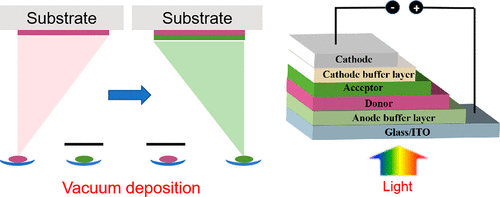Our official English website, www.x-mol.net, welcomes your
feedback! (Note: you will need to create a separate account there.)
Organic Semiconductors for Vacuum-Deposited Planar Heterojunction Solar Cells
ACS Omega ( IF 3.7 ) Pub Date : 2020-09-23 , DOI: 10.1021/acsomega.0c03868 Zhenzhen Zhang 1, 2 , Yuze Lin 1
ACS Omega ( IF 3.7 ) Pub Date : 2020-09-23 , DOI: 10.1021/acsomega.0c03868 Zhenzhen Zhang 1, 2 , Yuze Lin 1
Affiliation

|
Relative to widely used solution-processed bulk heterojunction organic solar cells (OSCs), planar heterojunction (PHJ) OSCs by vacuum-depositing active layers sequentially avoid tedious control of the blend film morphology, and it is easy to understand the physical process at the donor/acceptor interface. Here we summarize the developments of electron donor and acceptor materials for vacuum-deposited PHJ OSCs in the past decades and discuss the relationship between molecular structure and device performance. Finally, the challenges and prospects for the development of vacuum-deposited PHJ OSCs are also proposed. In addition to some basic requirements for high performance organic photovoltaic materials, such as broad and strong absorption, matched energy levels between donors and acceptors, and high charge carrier mobility, we suggest that extending the exciton diffusion length of organic photovoltaic materials should boost PHJ OSCs gradually become another option for organic photovoltaic application.
中文翻译:

用于真空沉积平面异质结太阳能电池的有机半导体
相对于广泛使用的溶液加工本体异质结有机太阳能电池(OSC),通过真空沉积活性层的平面异质结(PHJ)OSC避免了共混膜形貌的繁琐控制,并且易于理解供体处的物理过程/接受器接口。我们总结了过去几十年真空沉积PHJ OSC电子给体和受体材料的发展,并讨论了分子结构和器件性能之间的关系。最后,还提出了真空沉积PHJ OSC发展的挑战和前景。除了高性能有机光伏材料的一些基本要求,例如宽而强的吸收、供体和受体之间的匹配能级以及高载流子迁移率之外,我们建议延长有机光伏材料的激子扩散长度应该可以促进PHJ OSC逐渐成为有机光伏应用的另一种选择。
更新日期:2020-10-06
中文翻译:

用于真空沉积平面异质结太阳能电池的有机半导体
相对于广泛使用的溶液加工本体异质结有机太阳能电池(OSC),通过真空沉积活性层的平面异质结(PHJ)OSC避免了共混膜形貌的繁琐控制,并且易于理解供体处的物理过程/接受器接口。我们总结了过去几十年真空沉积PHJ OSC电子给体和受体材料的发展,并讨论了分子结构和器件性能之间的关系。最后,还提出了真空沉积PHJ OSC发展的挑战和前景。除了高性能有机光伏材料的一些基本要求,例如宽而强的吸收、供体和受体之间的匹配能级以及高载流子迁移率之外,我们建议延长有机光伏材料的激子扩散长度应该可以促进PHJ OSC逐渐成为有机光伏应用的另一种选择。











































 京公网安备 11010802027423号
京公网安备 11010802027423号